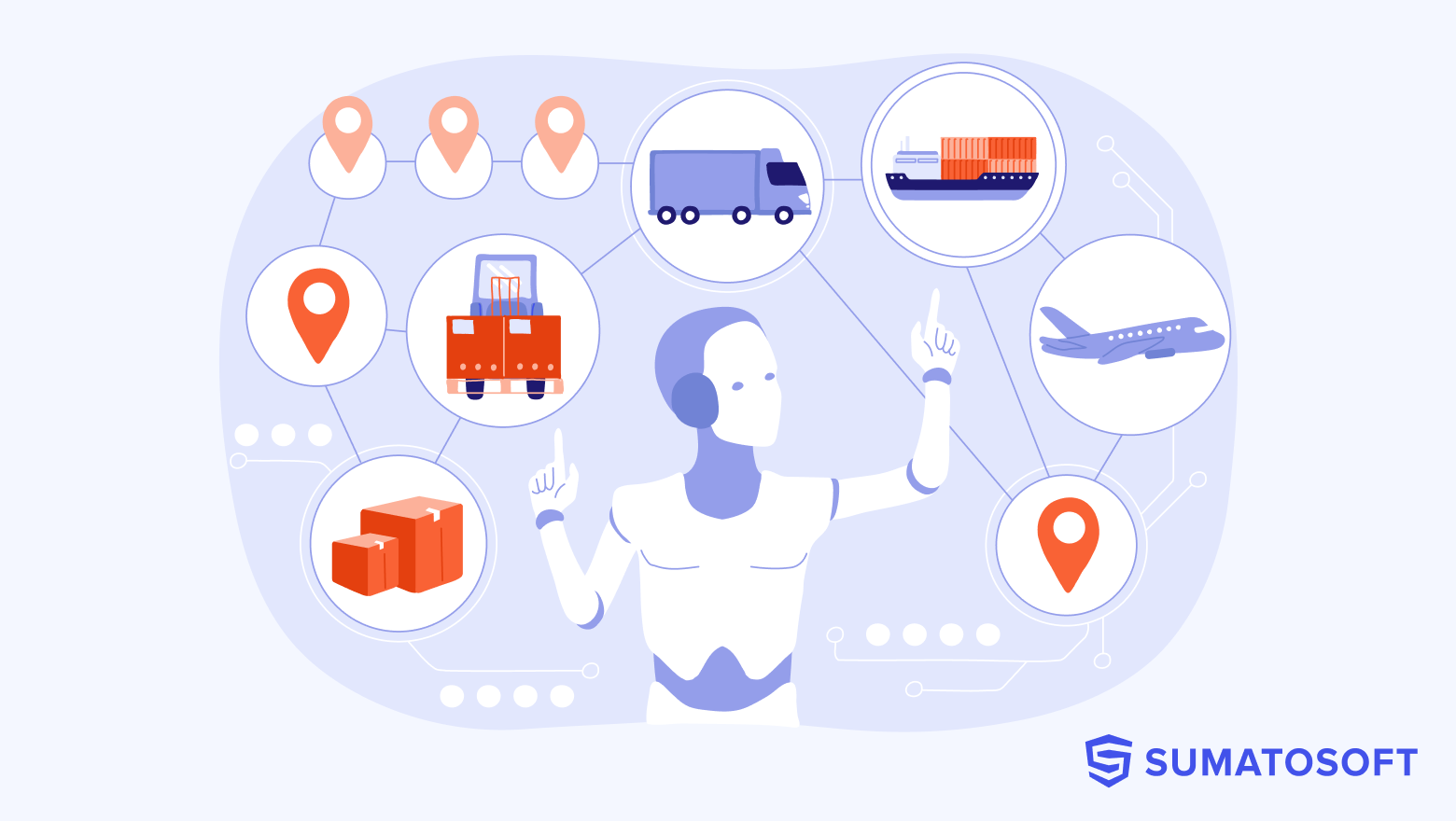Integrating AI into Business: A Complete Guide For 2025
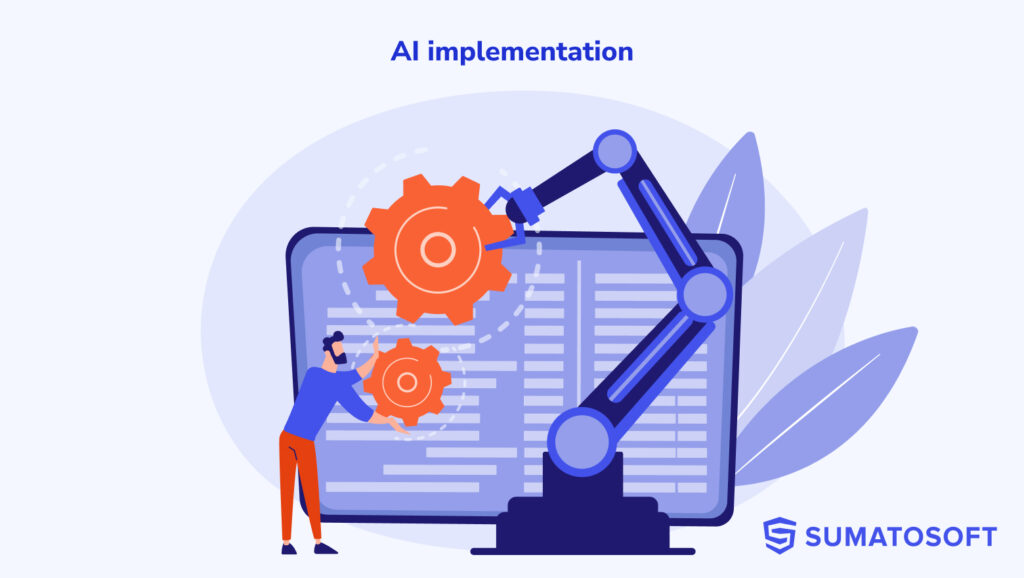
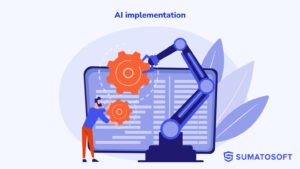
The world discusses AI, the government tries to regulate it, educational institutions integrate it into their curriculums, the media analyzes its societal impact, and businesses seek opportunities to benefit from it.
I wrote this guide because multiple companies referred to SumatoSoft for AI integration services in the past years, either searching for innovative products, enhancing operations of an established business, or seeking scalable solutions to remain competitive in their respective markets. However, diving into the world of AI can seem daunting without a clear roadmap.
This article provides a comprehensive step-by-step guide for businesses to harness the power of AI. Here, I briefly summarize our AI development and implementation efforts over the past years.
How Integrating AI Into Business Looks Like
AI implementation means embedding artificial intelligence into the daily operations of a business. Consider it as a virtual smart assistant that has access to your workflows and business information, can examine it, learn, make suggestions and recommendations, complete some tasks, and more.
Let me bring a little more clarity to how AI integration looks with some simple examples:
- Our Client used the AI-powered HR platform to analyze performance data, suggest career development paths, screen resumes, and shortlist candidates.
- Amazon uses AI-driven recommendation algorithms to analyze user behavior, purchase history, and browsing patterns and provide personalized recommendations.
- Domino’s leverages AI for its voice recognition system, “Dom,” to take phone orders and optimize delivery routes.
So, AI implementation means tailoring AI to solve specific issues, meet some business challenges, or unlock new opportunities that were previously unavailable. AI isn’t inherently supposed to replace humans – it’s more about extending human capabilities. Still, there are some cases where AI replaces humans, but nowadays, AI implementation is more characterized by collaboration between humans and AI.
AI is a broad term that encompasses a range of technologies designed to perform tasks that typically require human intelligence.
These include areas like natural language processing, image recognition, predictive analytics, and decision-making algorithms. I won’t specifically mention the particular area further in the article and use AI as a cumulative term.
What to Expect: Benefits of Implementing AI
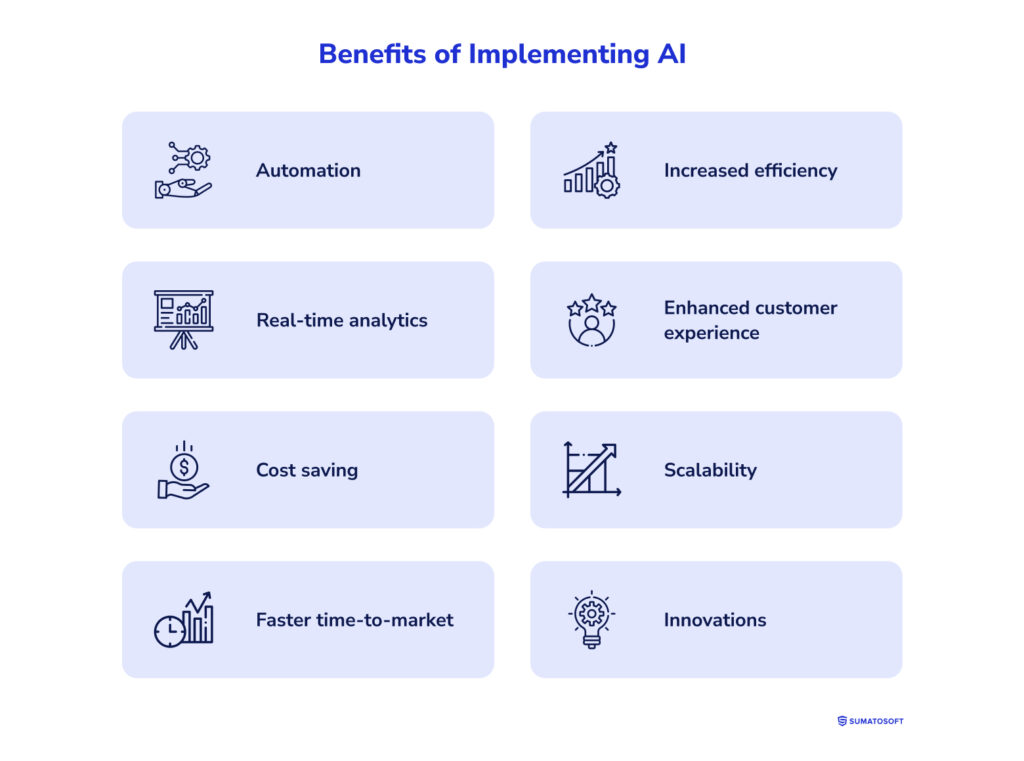
Here, I will focus on presenting AI capabilities through numbers rather than just concepts. The theoretical benefits of AI business integration will be reinforced with real-world statistics and case studies from companies that have successfully adopted this technology. But first things first, theory – here’s what businesses can expect from integrating AI into their workflows:
- Automation – the most evident and most famous benefit. It means automating repetitive tasks like data entry or inventory tracking, freeing up employee time either completely or partially.
- Increased efficiency – can a human process a 100-page document in a second? No. Can a human simultaneously monitor hundreds of live data streams from different sensors on a factory floor? Also no. AI excels at tasks such as analyzing documents, streams, or datasets in seconds.
- Real-time analytics – real-time monitoring of sales, inventory, or any other data stream enables immediate insights that would take humans hours to calculate manually. Some solutions, like autonomous cars, would be impossible without this AI benefit.
- Enhanced customer experience – from fully autonomous retail stores and chatbots to personalized recommendations based on customer buying preferences, AI boosts customer satisfaction and loyalty by enabling opportunities that were unimaginable before.
- Cost saving – probably the favorite business part. Since AI reduces manual effort and human errors, businesses can cut costs in areas like labor, supply chain, and inventory management. And don’t forget about increased efficiency – this benefit means tasks that previously took, for example, 20 hours to finish can now be done within 10-15, which also reduces costs.
- Scalability – AI enables businesses to scale operations without proportionally increasing costs, particularly in areas like customer support (e.g., chatbots handling thousands of queries simultaneously).
- Faster time-to-market – product design, prototyping, and testing efforts tend to be automated, speeding up the time-to-market.
- Innovations – a lot can be said here, but let’s examine some existing examples: predictive maintenance, autonomous fraud detection and prevention, smart supply chain management, AI-powered healthcare advisors, autonomous cars, and more.
Now, about numbers:
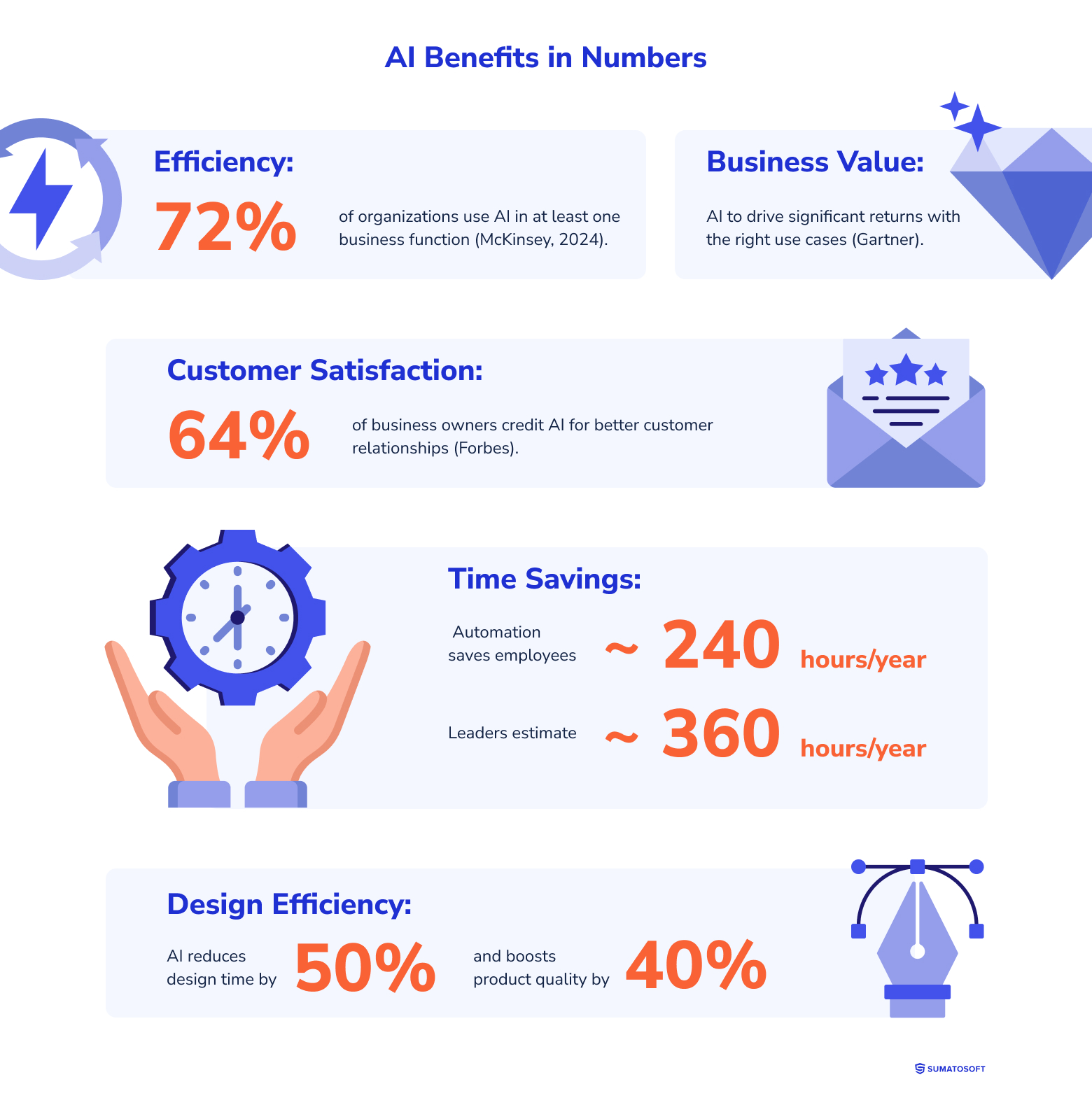
- Efficiency – according to McKinsey’s 2024 report, 72% of organizations have integrated AI into at least one business function, with many reporting increased efficiency and productivity.
- Business value creation – Gartner projects that AI will generate substantial business value in the coming years, emphasizing the importance of selecting appropriate AI use cases to maximize returns.
- Customer satisfaction – a Forbes report indicates that 64% of business owners view AI as an effective tool for enhancing customer relationships.
- Time savings – employees estimate that automating tasks could save them approximately 240 hours per year, while company leaders believe the savings could be around 360 hours annually.
- Design efficiency – the adoption of AI in product design has resulted in a 50% reduction in design time and a 40% increase in product quality.
And these are just a few. More and more industries are implementing AI for different purposes. I myself used AI to proofread this article before publishing it.
The Winner’s Path: 6 Steps to Implement AI in Business
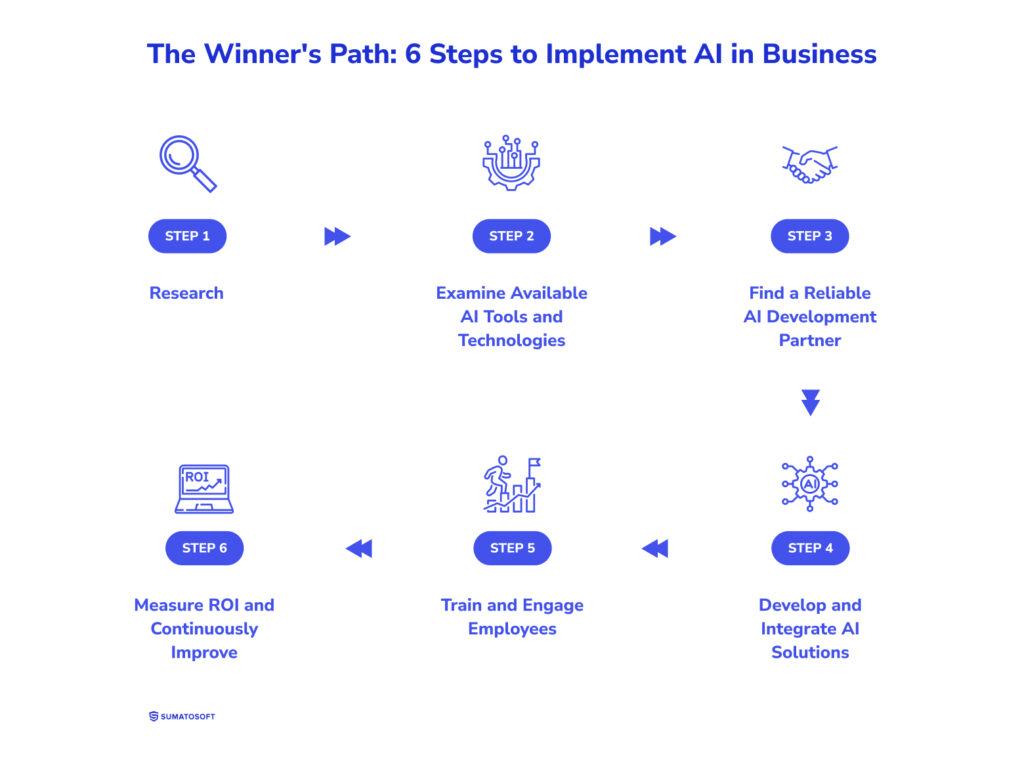
I’ve learned through countless AI integration projects that success doesn’t come by accident. It takes clear objectives, well-chosen tools, and a roadmap to navigate the complexities of implementation. I organized the AI implementation process into six actionable steps, each designed to contribute to successful AI adoption. Let’s answer the question of how to use AI in your business.
Step 1: Research
The journey starts with a map or a plan. The research step is about drawing it.
First of all, it’s necessary to define the specific challenge that AI can address in your organization.
- Do you have a specific pain point that you think AI could solve, or do you want to improve the overall efficiency?
- Is the goal focused on one department, or does it span multiple areas of the business?
- How does this goal align with your organization’s overall strategic objectives?
- Will achieving this goal reduce employee workload or increase their productivity?
- Do you plan to automate any workflows?
First and foremost, pinpoint the exact challenge where AI can make a difference in your organization
These are just a few questions. We at SumatoSoft help answer these and other questions during the Discovery phase. You can read more about this in our whitepaper on the Discovery Process.
Next, evaluate your company’s current infrastructure. This implies examining two areas: data infrastructure and technical skills.
AI is powered by data, so you need to feed it with your business data before getting insights and benefits from it. Robust and well-structured data collection means that your organization consistently gathers accurate, complete, and relevant data from various sources. You have data validation procedures, the data is organized and complete. If the data inside your organization is in a mess or there is no data-gathering mechanism, you will need to address these issues first before referring to AI.
Secondly, check if your team has the right skills to work with AI. This means having people who know data science, machine learning, and software engineering, as well as employees who can help your organization get used to using a new AI system and train others. Fortunately, we can offer our AI development services, which allow us to both develop and implement AI in your business.
Finally, a cost-benefit analysis will be conducted to ensure the investment in AI will pay off. This not only justifies the initiative to stakeholders but also sets realistic expectations for the impact AI will have on your operations.
Step 2: Examine Available AI Tools and Technologies

The number of AI tools and platforms has significantly grown over the past years, and finding the right one for your business became daunting. AI-powered CRMs, analytics platforms, automation and collaboration tools, custom-built and off-the-shelf solutions – literally, you can spend hours browsing different options.
Custom vs. Off-the-Shelf Solutions
While off-the-shelf solutions might seem tempting, they’re not automatically the go-to solution. Off-the-shelf tools often provide quick wins with minimal setup, while custom solutions can be tailored for highly specific business challenges. Moreover, the first off-the-shelf solution found is likely the wrong one, so my personal advice: keep looking.
Leverage the Power of Rating Platforms
Leverage platforms like G2 or Capterra to research and compare the latest AI tools – these platforms offer reviews and ratings and often go with real-life examples of how other businesses used the solution, what challenges they faced and what they got from it.
Use Systematic Approach
Finally, create a framework for assessing tools based on key factors such as scalability, integration ease, cost, vendor support, etc. A thorough evaluation ensures that the chosen tools align with both your immediate and long-term business goals.
Step 3: Find a Reliable AI Development Partner
We now move to an exciting and crucial step: selecting the right partner to integrate an AI solution. Whether you choose an off-the-shelf option or decide to build a custom solution, having an experienced and reliable partner can make all the difference.
This is a broad topic on its own, and we at SumatoSoft have covered it extensively in multiple articles, which I’ll reference at the end of this section. For now, let me provide a concise summary of the key points from these materials.
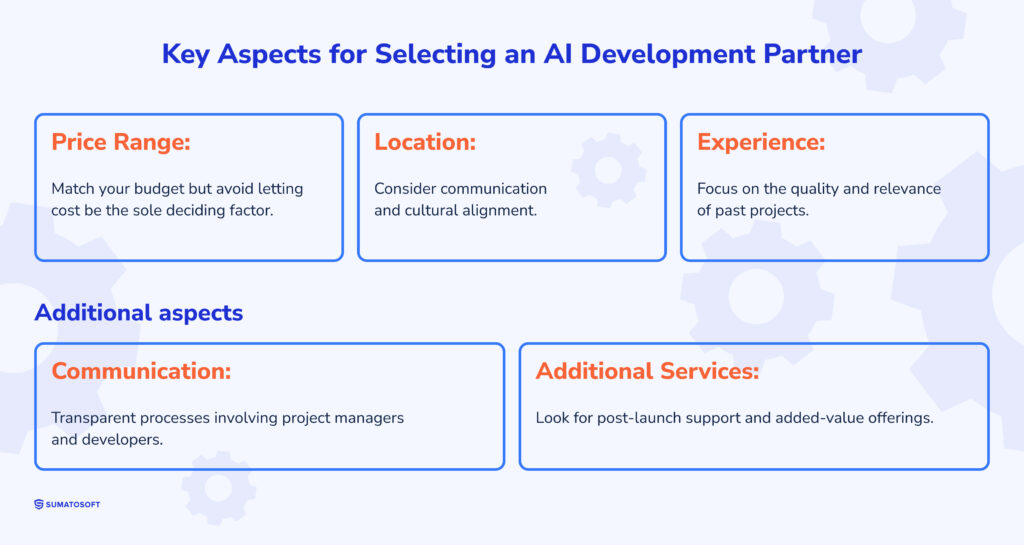
Start by creating a list of potential companies and collecting primary information about them, such as their services, expertise, and Client feedback. Platforms like Google, Clutch, or GoodFirms can help you identify candidates but don’t stop at the top search results—dig deeper to find less-marketed but competent companies.
Pay close attention to three key aspects:
- price range;
- location;
- experience.
The price should match your budget, but don’t let cost be the sole deciding factor. Consider whether the location of the company matters for communication or cultural alignment. For experience, focus on the quality and relevance of their past projects rather than just the quantity.
Communication is another critical factor. Ensure the company provides clear and transparent communication and involves team members beyond salespeople, such as project managers and developers. Check if they offer additional services like post-launch support, which can add value to your project.
By carefully evaluating these aspects and aligning them with your goals, you can ensure a strong partnership that contributes to the successful implementation of AI in your organization.
Helpful information on this topic:
- comprehensive whitepaper on how to choose the right technological partner;
- use our Excel template for company selection;
- read our articles on the best software developers in Eastern Europe and the best offshore development companies.
Step 4: Develop and Integrate AI Solutions
At this step, the final AI solution truly takes shape. During this step, a technological partner like SumatoSoft transforms theoretical plans into practical applications that will be integrated into business operations later. The development is carried out by a software development provider.
At SumatoSoft, we follow an iterative software development process to transform ideas into functional products. Our approach emphasizes transparency, business value delivery, and close collaboration with Clients.

Our process begins with a project kickoff, bringing together key participants to establish a shared understanding and address organizational matters. We then proceed through structured phases, including planning, designing, coding, testing, and deployment. Each phase involves iterative development, continuous testing, and Client involvement to ensure alignment with business goals and adaptability to challenges.
One more necessary investment at this step is in data quality and governance. I’ve touched upon this topic in the research section, but here you need a specific set of actions on how your business will manage data effectively after artificial intelligence implementation.
Let’s break down these two concepts:
Data Quality
Data quality refers to the accuracy, consistency, and reliability of data. As the lifeblood of any AI system, high-quality data is as essential to AI as fresh air is to humans. Poor or incomplete data can result in inaccurate predictions, biased models, and flawed analysis.
Ensuring the data meets key quality characteristics is the responsibility of a software development provider. However, from your side, it’s crucial for you to understand the importance of investing in data quality.
Prepared, high-quality data is a necessary first step for AI implementation.
Data Governance
Data governance refers to measures, procedures, policies, processes, standards, and any other management tools that unify the data management within the organization. So, approach it as describing any other workflow or business process within your organization with the key difference that data governance focuses on managing and optimizing your organization’s data assets. This means creating clear rules for how data is collected, stored, accessed, and used across all departments.
Together, data quality and governance ensure that the data used in AI systems form a solid foundation for successful AI business integration. During our AI development services, we help to ensure proper data quality and governance in your organization.
Step 5: Train and Engage Employees
Artificial intelligence implementation is not just about deploying tools – it’s about ensuring they are adopted by employees. Even the most advanced AI system will fail to deserve recognition among workers without a positive attitude toward it. Build a positive environment around AI adoption, highlight its benefits, provide hands-on training, and in general, create user-friendly interfaces to encourage adoption. Remember, the process doesn’t end once the new AI system is launched – keep working with adoption over time.
Before introducing AI tools, optimize the core processes that they will impact. AI is not a panacea for broken workflows. Just as a house needs a strong foundation, well-established processes are critical to success. Some additional advice:
- Communicate early and often about upcoming changes.
- Inform employees about how AI will enhance their work and maintain a systematic feedback loop.
- Listen to feedback from users during the adoption period.
- It’s not necessary to modify software after every piece of negative feedback because unplanned modifications lead to scope creep. But even listening to end users can help increase adoption rates.
- Celebrate milestones and encourage employees.
- Use rewards, promote learning programs, and track progress visibly to foster excitement around the new tools.
- Select champions familiar with the AI system to guide others, answer questions, and troubleshoot.
- For custom solutions, provide early access and extra training to designated employees.
Step 6: Measure ROI and Continuously Improve
At the research stage, you defined Key Performance Indicators (KPIs) to measure the success of AI implementation. Examples of KPIs include cost savings, efficiency improvements such as faster task completion, increased positive customer reviews, and revenue growth.
After implementation, consistently monitor these metrics to evaluate whether your AI solution meets the targeted goals. If the results fall short, investigate potential reasons, such as inaccurate initial estimations, unanticipated challenges, or incomplete adoption.
It’s perfectly normal for initial expectations to be unrealistic or overly ambitious. The flexibility and creativity in technology adoption are what differentiates a successful implementation from a failed one.
Practical Tips for Seamless Integration: How to Overcome Common Challenges
Now, let’s move on to an insider section where I share what we’ve learned over the years of AI adoption. At SumatoSoft, we hold retrospective sessions after every project to analyze what was done well and where we could improve in our process.
This section is a brief summary of those sessions.
| Challenge | The essence | How to overcome |
|---|---|---|
| Resistance to change | Employees resist adopting AI due to uncertainty, fear of change, or lack of trust in the technology. | Involve stakeholders early, openly communicate about AI tools they already use, and include employees in discussions. |
| Lack of in-house expertise | Insufficient in-house skills or knowledge to implement and manage AI solutions. As a result, the whole value of software development reaches zero. | Provide training programs, hire AI specialists or partner with vendors for expert guidance. We provide comprehensive staff training during the first several months of onboarding. |
| Poor data quality | Inconsistent, incomplete, or messy data. Attempts to extract the value from it lead to time wasted with near-zero value for business. | Establish data governance frameworks, ensure consistent data collection, and invest in data cleaning and validation. |
| Budget limitations | Limited financial resources make AI implementation challenging. Projects are sometimes abandoned when ambitions and desired functionalities exceed the available budget. | Start with small pilot projects that deliver measurable ROI, then use results to justify further investment. |
| Unrealistic expectations | Over-promising AI outcomes leads to disappointment and failure. | Set clear, achievable goals aligned with business needs to manage expectations effectively. |
| Integration challenges | Off-the-shelf AI tools may not be compatible with existing IT systems or workflows. | Examined the integration opportunities of such solutions before buying them or referring to the software development provider for its integration. Get a free consultation from the AI tool’s sales team beforehand – it will allow you to save both time and money. |
AI in Action: Real-World Applications Across Industries
I drew one more table to present AI applications across industries. I have to limit myself to just two application examples per industry and include only 8 industries. With globally recognized industries numbering around 20 to 30, depending on classification systems like NAICS or GICS, a comprehensive list of examples is worthy of a separate article.
For now, I want to provide an overview of industries and use cases rather than an in-depth examination.
| Industry | Use cases |
|---|---|
| Customer support | A customer contacts a company via an AI chatbot, which instantly resolves their issue by accessing information from the database. Sentiment analysis identifies dissatisfied customers in email feedback and notifies human support for resolution. |
| Inventory management | An AI advisor analyzes historical orders and upcoming events, identifies a surge in demand during upcoming holidays, and recommends restocking. Real-time inventory monitoring alerts a manager about an overstocked item. |
| Manufacturing | Predictive maintenance notifies a technician that a machine will require servicing within a week. Automated quality control systems detect defects in a production line and halt operations to prevent further waste. |
| Office work | During a meeting, an AI-powered tool transcribes the conversation and generates a summarized action list.An AI assistant helps draft professional emails that align with company guidelines, ensuring consistency in tone and messaging. |
| Finance | AI detects unusual spending patterns on a credit card and blocks the card until the case resolution. AI analyzes customer data and credit histories to provide accurate risk scores for loan approvals. |
| Energy | AI predicts electricity demand during extreme weather, enabling utilities to optimize power generation.Renewable energy operators use AI to forecast solar and wind output, improving grid integration and stability. |
| Agriculture | Farmers use AI to analyze drone images and identify areas of crops requiring water or fertilizer.AI-driven weather prediction tools help plan planting schedules to maximize yield. |
| Education | Automated grading tools evaluate assignments, providing instant feedback to students.AI chatbots help to study materials by explaining them in an accessible to the specific student way. |
| Legal services | AI tools review contracts and identify risks or inconsistencies. AI-powered research tools browse the case law to find relevant precedents for ongoing litigation. |
AI Implementation with SumatoSoft’s Expert Team
At SumatoSoft, we offer AI development services that transform data into value. We specialize in developing GPT-powered chatbots, recommendation engines, predictive analytics, video/image recognition platforms, and generative AI for creative content.
With over 250 successful projects across industries like eCommerce, eLearning, Finance, Real Estate, Logistics, Travel, and more, our expertise spans all aspects of AI—from natural language processing and speech recognition to computer vision and robotics.
Our Clients consistently praise the results, noting that we meet high standards and often exceed expectations. Recognized as top software developers by leading analyst agencies such as Techreviewer, Clutch, and GoodFirms, we take pride in delivering exceptional quality.
This list of achievements could go on, but the best way to experience our capabilities is to try us out—especially since we offer a free quote for your project. Contact us today!
Conclusion
A lot was told, and even more was left unsaid, as the possibilities of AI are only limited by our imagination. Over the past years, I’ve witnessed how AI transformed existing businesses, how tech-forward visionaries came up with truly innovative solutions, and how businesses tried to implement AI because it was trendy rather than for some need.
Now, it’s your turn. Start by evaluating your needs, take small but meaningful steps, and approach AI with a blend of ambition and realism. I believe the future of your business is bright with AI, and I hope this guide has given you the confidence to take that first step. Let’s make the future happen, together.
Let’s start
If you have any questions, email us info@sumatosoft.com

